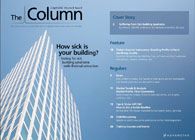Fried food
Researchers from the University of Basque, Spain, have conducted an experiment into different cooking oils and discovered that compounds known as aldehydes released from the oils increase the risk of neurologic degenerative diseases and several different cancers.
Researchers from the University of Basque, Spain, have conducted an experiment into different cooking oils and discovered that compounds known as aldehydes released from the oils increase the risk of neurologic degenerative diseases and several different cancers.1
Three types of oil (extra virgin olive, sunflower and virgin linseed oils) were examined and subjected to 190 °C for an extended period of time. The oils were then analysed using gas chromatography–mass spectrometry. This was the first time that the presence of 4-oxo‑(E)-2‑decenal and 4-oxo-(E)-2-undecenal have been detected, not only in frying oils, but also in foods. In addition, the concentration of aldehydes such as 4-hydroxy-(E)-2-nonenal, (E)-4,5-epoxy‑(E)‑2‑decenal, 4-hydroxy-(E)-2‑hexenal and 4-oxo-(E)-2-nonenal have been determined simultaneously for the first time in these oils submitted to frying temperature.
The team concluded that the significant concentration of these toxic compounds, particularly in sunflower and virgin linseed oils, is a cause for concern.
1. Maria D. Guillén, Patricia S. Uriarte, Food Chemistry, 131(3), 915 (2012).
This story originally appeared in The Column. Click here to view that issue.
Removing Double-Stranded RNA Impurities Using Chromatography
April 8th 2025Researchers from Agency for Science, Technology and Research in Singapore recently published a review article exploring how chromatography can be used to remove double-stranded RNA impurities during mRNA therapeutics production.
The Effect of Time and Tide On PFAS Concentrations in Estuaries
April 8th 2025Oliver Jones and Navneet Singh from RMIT University, Melbourne, Australia discuss a recent study they conducted to investigate the relationship between tidal cycles and PFAS concentrations in estuarine systems, and offer practical advice on the sample preparation and LC–MS/MS techniques they used to achieve the best results.












